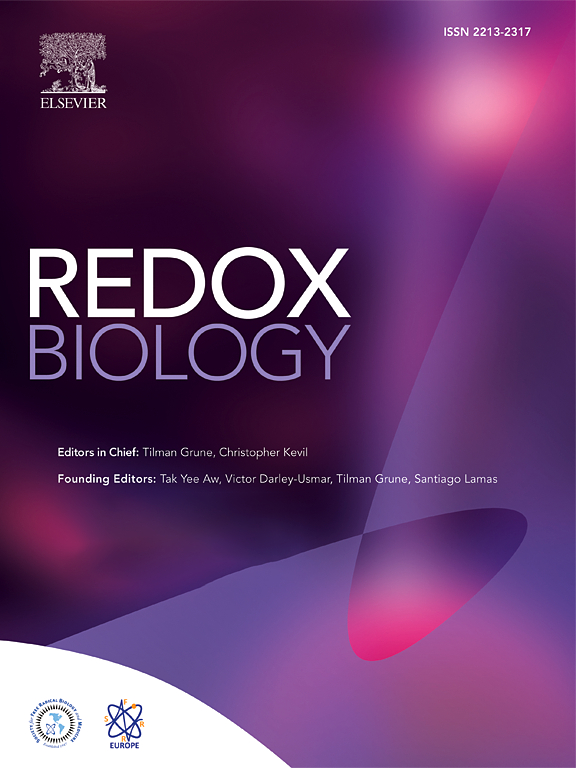A critical role for gastric xanthine oxidoreductase in the formation of S-nitrosothiols and blood pressure responses to nitrite in rats
IF 10.7
1区 生物学
Q1 BIOCHEMISTRY & MOLECULAR BIOLOGY
引用次数: 0
Abstract
Nitrite and nitrate bioactivation to nitric oxide (NO) in the enterosalivary cycle of nitrate offers an enormous therapeutic potential for cardiovascular and metabolic diseases and involves xanthine oxidoreductase (XOR), an enzyme widely expressed in the gastrointestinal system. XOR has nitrite reductase activity, reducing nitrite to NO, especially under low pH conditions. Here, we hypothesized that XOR activity critically interacts with acidic gastric pH to cause the blood pressure responses to oral nitrite. To test this hypothesis, rats pretreated with the XOR inhibitor allopurinol (100 mg/kg, by gavage, or vehicle) were treated with N⍵-nitro-l-arginine methyl ester; 60 mg/kg, i.v.) to induce acute hypertension, and received sodium nitrite (1, 5, and 15 mg/kg) in the stomach or in the duodenum. Mean arterial blood pressure (MAP) was monitored invasively. Ozone-based reductive chemiluminescence assays were performed to evaluate plasma nitrite, nitrate, total nitrosylated species and S-nitrosothiols (RSNO) concentrations. Gastric pH was assessed and XOR activity in the stomach and duodenum was assessed by fluorimetry. We found more profound MAP responses to nitrite administered in the duodenum than in the stomach. Importantly, XOR inhibition completely blunted nitrite-induced RSNO formation and hypotensive responses when nitrite is administered in the stomach, whereas XOR inhibition did not affect the responses when nitrite was administered in the duodenum, even though XOR activity is much higher in the duodenum than in the stomach. These results suggest a critical interaction between XOR activity and gastric acidity in mediating RSNO formation and the cardiovascular effects of oral nitrite. These results may help to design better oral nitrite therapeutic formulations.

胃黄嘌呤氧化还原酶在大鼠s -亚硝基硫醇形成和血压对亚硝酸盐反应中的关键作用
在硝酸盐的肠唾液循环中,亚硝酸盐和硝酸盐对一氧化氮(NO)的生物活化为心血管和代谢性疾病提供了巨大的治疗潜力,并涉及黄嘌呤氧化还原酶(XOR),这是一种在胃肠道系统中广泛表达的酶。XOR具有亚硝酸盐还原酶活性,可将亚硝酸盐还原为NO,特别是在低pH条件下。在这里,我们假设XOR活性与酸性胃pH值严重相互作用,导致口服亚硝酸盐的血压反应。为了验证这一假设,用XOR抑制剂别嘌呤醇(100 mg/kg,灌胃或载药)预处理大鼠,用N -硝基-l-精氨酸甲酯处理;60 mg/kg,静脉注射)诱导急性高血压,胃或十二指肠分别给予亚硝酸钠(1、5、15 mg/kg)。有创监测平均动脉血压(MAP)。采用臭氧还原化学发光法测定血浆亚硝酸盐、硝酸盐、总亚硝基化物质和s -亚硝基硫醇(RSNO)浓度。采用荧光法测定胃pH值,测定胃和十二指肠的XOR活性。我们发现,与胃相比,十二指肠对亚硝酸盐的MAP反应更深刻。重要的是,当亚硝酸盐在胃中给药时,异或抑制完全钝化了亚硝酸盐诱导的RSNO形成和降压反应,而当亚硝酸盐在十二指肠中给药时,异或抑制不影响反应,尽管异或活性在十二指肠中比在胃中高得多。这些结果表明,XOR活性和胃酸在介导RSNO形成和口服亚硝酸盐对心血管的影响中具有重要的相互作用。这些结果可能有助于设计更好的口服亚硝酸盐治疗配方。
本文章由计算机程序翻译,如有差异,请以英文原文为准。
求助全文
约1分钟内获得全文
求助全文
来源期刊

Redox Biology
BIOCHEMISTRY & MOLECULAR BIOLOGY-
CiteScore
19.90
自引率
3.50%
发文量
318
审稿时长
25 days
期刊介绍:
Redox Biology is the official journal of the Society for Redox Biology and Medicine and the Society for Free Radical Research-Europe. It is also affiliated with the International Society for Free Radical Research (SFRRI). This journal serves as a platform for publishing pioneering research, innovative methods, and comprehensive review articles in the field of redox biology, encompassing both health and disease.
Redox Biology welcomes various forms of contributions, including research articles (short or full communications), methods, mini-reviews, and commentaries. Through its diverse range of published content, Redox Biology aims to foster advancements and insights in the understanding of redox biology and its implications.
 求助内容:
求助内容: 应助结果提醒方式:
应助结果提醒方式:


